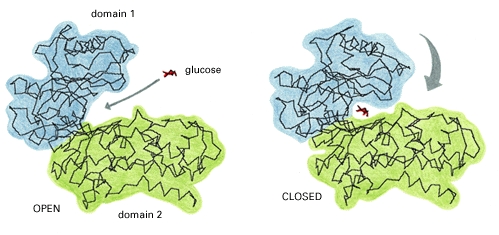Sandbox 172
From Proteopedia
Contents |
Hexokinase Type I
Hexokinase Type I is one of four hexokinase isoenzymes that participate in glycolysis. Hexokinase catalyzes the phosphorylation of glucose into glucose-6-phosphate (G6P) providing enough activation energy for the glycolytic process to start. Thus hexokinase allows the muscle cells to take up glucose in the blood and use it as an energy source for different actions and expenditures. Hexokinase Type I is mainly found in mammalian tissues; it is crucial enzyme in maintaining a downward concentration gradient to provide a steady influx of glucose into cells.
| |||||||||
| 1cza, resolution 1.90Å () | |||||||||
|---|---|---|---|---|---|---|---|---|---|
| Ligands: | , , | ||||||||
| Activity: | Hexokinase, with EC number 2.7.1.1 | ||||||||
| Related: | 1hkb, 1hkc | ||||||||
| |||||||||
| |||||||||
| Resources: | FirstGlance, OCA, RCSB, PDBsum | ||||||||
| Coordinates: | save as pdb, mmCIF, xml | ||||||||
Introduction
Four types of hexokinase isozymes exist in the human biological system. They all serve to catalyze the exact same reaction in glycolysis even though they are encoded by different sets of genes. The hexokinase types I-III all have a high affinity for glucose and become subject to inhibition in the presence of glucose-6-phosphate- the first step reaction product in glycolysis. Hexokinase type I is the predominant form in the muscle while hexokinase type II is the predominant form in myocytes. Hexokinase type IV varies from the other three hexokinase types as it is not inhibited by the production of glucose-6-phosphate and shows a lower affinity for glucose. Hexokinase type I and II have the particular ability to bind to outer mitochondrial membrane, this binding happens both specifically and reversibly.[1]
Structure
The size of hexokinase type I is approximately 100 kD. Hexokinase type I is constructed by a N-terminal regulatory domain and a C-terminal catalytic domain joined together by an alpha helix. The glucose binding site of hexokinase type I can be found within the two sub-units that make up the isoenzyme, these are known as lobes. Factors that contribute to the binding of glucose to this active site include amino acids within the actual site and hydrogen bonding that takes place on the glucose between the hydroxyl groups.
Glucose Binding Sites
The residues of the glucose binding site of Hexokinase Type I are very highly conserved within the hexokinase sequence; glucose binds equally to both domains or "lobes" of the structure. As a result, hexokinase type I in its native conformation has an active site in its inactive regulatory domains. Before glucose binds to hexokinase type I, it is said to be in an open conformation. ATP is already bound within one of the domains but it is situated a distance from the glucose binding site. As the glucose binds, the two domains close around the glucose substrate and this change results in a newly formed pattern of hydrogen bonding.
Active Site
In the of hexokinase type I, Lys 621 and Asp 657 show the hydrogen-bonding distance in which a reactive O6 hydroxyl is situated in between.
References
- ↑ Garavito R., Mulichuk A., Padmanabhan K., Wilson J. The structure of mammalian hexokinase-1. Nature Structural and Molecular Biology. 1998. 5: 555-560.
| Please do NOT make changes to this Sandbox until after April 23, 2010. Sandboxes 151-200 are reserved until then for use by the Chemistry 307 class at UNBC taught by Prof. Andrea Gorrell. |


